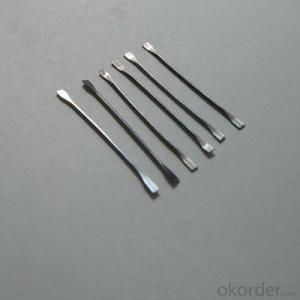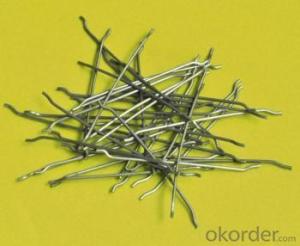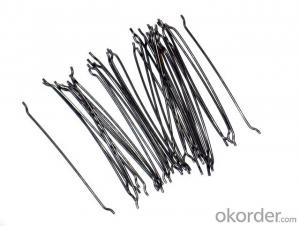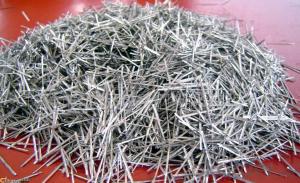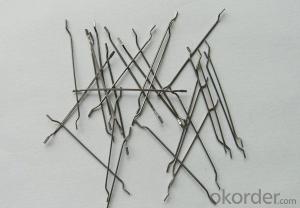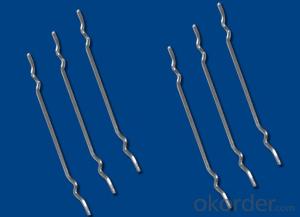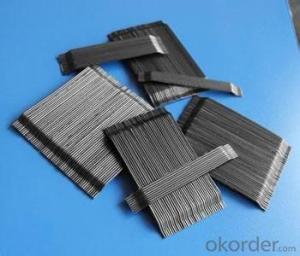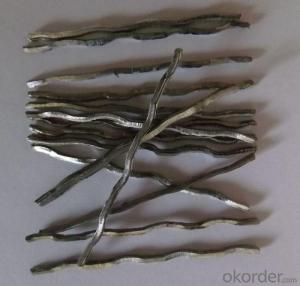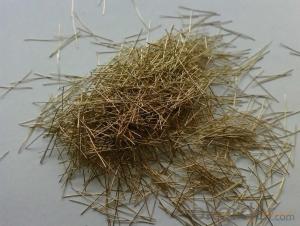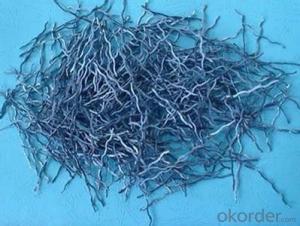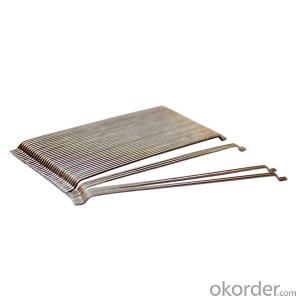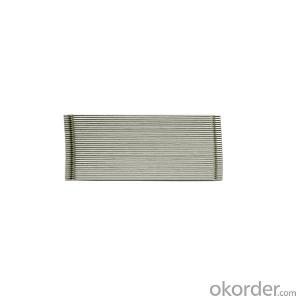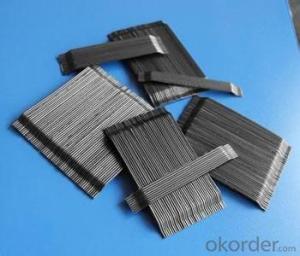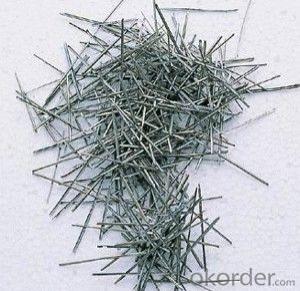Melt Extract Stainless Steel Fiber Reinforced Steel Fiber Glued for Copper Plating Construction and Copper Fiber
- Loading Port:
- Tianjin
- Payment Terms:
- TT OR LC
- Min Order Qty:
- 5 kg
- Supply Capability:
- 250000 kg/month
OKorder Service Pledge
OKorder Financial Service
You Might Also Like
Quick Details
Place of Origin: Shandong, China (Mainland), Shandong, China (Mainland)
Model Number: GLUED, glued steel fiber
Material: Steel
type: steel fiber for concrete reinforcement
material: steel wire
shape: glued together in a row
appearance: clear and bright
Product features
glued steel fiber together in a row ,is used with cement for construction
Concrete steel fiber is specifically to enhance concrete in its hardened state ,the uniform distribution of steel fiber throughout the concrete greatly improve concrete bonding and tensile strength ,additionally it provides exceptional load stability and durability ,as reliable and efficient concrete reinforcement material
it is widely ued in buildings ,bridges ,thin roo engineering ,highway etc.
Specifications
Steel fiber for Concrete Reinforcement
1.High tensile strength 2.Length 6-60mm 3.Diameter 0.2-1.0mm
Steel fiber for Concrete Reinforcement
1.High tensile strength
2.Length 6-60mm
3.Diameter 0.2-1.0mm
4.ISO9001, CE, TUV
Specification | Diameter (mm) | Length (mm) | Aspect ratio (L/D) | Tensile strength (Mpa) |
0.12/6 | 0.12 | 6 | 50 | 2500 |
0.2/6 | 0.2 | 6 | 30 | 2500 |
0.2/13 | 0.2 | 13 | 65 | 2500 |
0.3/25 | 0.3 | 25 | 83 | 2500 |
0.4/25 | 0.4 | 25 | 63 | 1200 |
0.4/30 | 0.4 | 30 | 75 | 1200 |
0.5/30 | 0.5 | 30 | 60 | 1100 |
0.5/25 | 0.5 | 25 | 50 | 1100 |
0.55/25 | 0.55 | 25 | 45 | 800 or 1000 |
0.6/30 | 0.6 | 30 | 50 | 1000 or 1100 |
0.7/30 | 0.7 | 30 | 43 | 1000 |
0.7/35 | 0.7 | 35 | 50 | 1000 |
0.75/35 | 0.75 | 35 | 47 | 1000 |
0.75/60 | 0.75 | 60 | 80 | 1000 |
0.8/60 | 0.8 | 60 | 75 | 1000 |
0.9/50 | 0.9 | 50 | 56 | 1000 |
0.9/60 | 0.9 | 60 | 67 | 1000 |
1.0/50 | 1.0 | 50 | 50 | 1000 |
1.0/60 | 1.0 | 60 | 60 | 1000 |
Picture
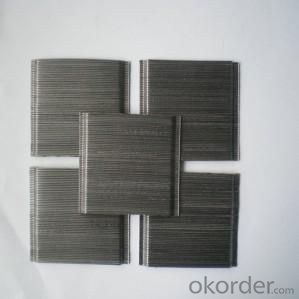
Adhesion into a row

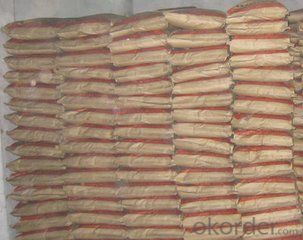
any type steel fiber
FAQ
copper plating steel fiber,construction,copper fiber
we can produce any type steel fiber and of course we can make production according to your requirement
we have specilize in this field for almost 10 years ,with good quality and competitive price
- Q: How does the addition of melt extract stainless steel fiber impact the flowability of concrete?
- The addition of melt extract stainless steel fiber can significantly impact the flowability of concrete. Stainless steel fibers are typically added to concrete to enhance its mechanical properties, such as increasing its tensile and flexural strength, improving its durability, and reducing cracking. However, the addition of stainless steel fibers can also affect the flowability of the concrete mixture. The presence of fibers in the concrete can increase its viscosity, making it more resistant to flow. This can be particularly noticeable in high fiber volume concrete mixtures. The flowability of concrete is commonly measured using the slump test, which measures the consistency and workability of the concrete. When stainless steel fibers are added, the slump of the concrete can decrease, indicating a reduction in flowability. Nevertheless, the impact of stainless steel fibers on flowability can be controlled and managed through proper mix design and dosage. By adjusting the fiber content, the size and shape of the fibers, and the water-to-cement ratio, the flowability of the concrete can be optimized to meet the specific requirements of the project. In conclusion, the addition of melt extract stainless steel fibers can have a noticeable impact on the flowability of concrete. However, with proper mix design and dosage, the flowability can be controlled and adjusted to achieve the desired performance characteristics of the concrete.
- Q: Can melt extract stainless steel fiber be used in railway tracks or train platforms?
- Yes, melt extract stainless steel fiber can be used in railway tracks or train platforms. Stainless steel fibers are known for their high strength, corrosion resistance, and durability, making them suitable for various infrastructure applications. When used in railway tracks or train platforms, stainless steel fibers can enhance the structural integrity and longevity of these surfaces. They can help reduce cracking, prevent the formation of potholes, and improve resistance to wear and tear caused by heavy train traffic. Additionally, stainless steel fibers are also effective in providing reinforcement against thermal expansion and contraction, ensuring the stability and safety of railway tracks and platforms. Therefore, melt extract stainless steel fiber is a viable option for enhancing the performance and longevity of railway tracks and train platforms.
- Q: What is the effect of melt extract stainless steel fiber on the modulus of toughness of concrete?
- Adding melt extract stainless steel fiber to concrete has a beneficial impact on the modulus of toughness. Stainless steel fibers possess high tensile strength and ductility, which contribute to enhancing the overall toughness of the concrete. When these fibers are evenly distributed throughout the concrete matrix, they serve as reinforcement, resulting in improved resistance to cracking and enhanced ability to withstand impact and cyclic loading. The melt extract stainless steel fibers enhance the bridging effect within the concrete by effectively distributing tensile stresses and preventing the spread of cracks. This leads to increased energy absorption capacity and enhanced resistance to crack formation and propagation. Consequently, the modulus of toughness of the concrete experiences significant improvement. Furthermore, incorporating stainless steel fibers in concrete can also enhance its durability by reducing the risk of corrosion and increasing resistance to extreme temperatures and chemical attacks. This further contributes to the overall enhancement of the modulus of toughness. To summarize, the addition of melt extract stainless steel fiber positively affects the modulus of toughness in concrete by enhancing resistance to cracking, improving energy absorption capacity, and increasing overall durability.
- Q: What is the recommended fiber volume fraction for melt extract stainless steel fiber in concrete?
- The recommended fiber volume fraction for melt extract stainless steel fiber in concrete typically ranges from 0.5% to 2.0% by volume.
- Q: What are the requirements for storage and handling of melt extract stainless steel fiber?
- The requirements for storage and handling of melt extract stainless steel fiber include several key factors to ensure the integrity and quality of the product. 1. Temperature: The storage area should be maintained at a moderate temperature to prevent any adverse effects on the stainless steel fiber. Extreme high or low temperatures can potentially alter the properties of the fiber and affect its performance. 2. Humidity: It is important to store the melt extract stainless steel fiber in a dry environment to avoid any moisture absorption. Moisture can lead to corrosion and weaken the fiber, thereby reducing its effectiveness. 3. Packaging: The fiber should be stored in its original packaging or airtight containers to prevent exposure to air, dust, and other contaminants. This helps to maintain the cleanliness and quality of the fiber. 4. Handling: When handling the stainless steel fiber, it is crucial to use appropriate protective equipment such as gloves and safety glasses to avoid any injuries. The fiber can have sharp edges, so care should be taken to prevent cuts or abrasions. 5. Avoiding contact with other metals: The stainless steel fiber should be stored separately from other metals, especially those that are prone to corrosion. Contact with other metals can cause galvanic corrosion, which can degrade the fiber's performance. 6. Proper labeling and identification: It is important to properly label and identify the melt extract stainless steel fiber to ensure its traceability and avoid any confusion with other materials. This helps in maintaining quality control and efficient inventory management. By following these requirements for storage and handling, the melt extract stainless steel fiber can be preserved in its optimal condition, ensuring its reliability and longevity in various applications such as reinforcement in concrete, thermal insulation, and electrical conductivity.
- Q: Can melt extract stainless steel fiber be used in tunneling and underground construction?
- Yes, melt extract stainless steel fiber can be used in tunneling and underground construction. This type of fiber is commonly used to reinforce concrete and enhance its mechanical properties, making it suitable for various applications in tunneling and underground construction projects. It helps to improve the structural integrity of concrete, increase its resistance to cracking and improve overall durability, making it an ideal choice for these types of projects.
- Q: How does melt extract stainless steel fiber affect the carbonation resistance of concrete?
- Melt extract stainless steel fiber can significantly enhance the carbonation resistance of concrete. Carbonation is a chemical process where carbon dioxide from the atmosphere reacts with the calcium hydroxide in concrete to form calcium carbonate. This process can lead to a reduction in the alkalinity of the concrete, which in turn can result in the corrosion of embedded reinforcement and a decrease in the overall durability of the structure. By incorporating melt extract stainless steel fiber into concrete, it creates a three-dimensional reinforcement network that helps to improve the mechanical properties and durability of the concrete. The stainless steel fibers act as a physical barrier, reducing the ingress of carbon dioxide into the concrete matrix. This barrier effect slows down the carbonation process, effectively increasing the carbonation resistance of the concrete. Additionally, the stainless steel fibers also enhance the overall mechanical properties of the concrete, making it more resistant to cracking and spalling. This increased resistance to cracking further reduces the potential for carbon dioxide to penetrate the concrete, as cracks provide pathways for gas diffusion. Furthermore, the stainless steel fibers can also help to mitigate the effects of carbonation by providing an additional level of corrosion protection to the embedded reinforcement. The fibers act as sacrificial anodes, diverting any potential corrosion initiation sites away from the reinforcement and onto themselves. This sacrificial anode effect helps to prolong the service life of the concrete structure by reducing the risk of reinforcement corrosion due to carbonation. In summary, melt extract stainless steel fiber positively affects the carbonation resistance of concrete by acting as a physical barrier, enhancing mechanical properties, and providing additional corrosion protection to the embedded reinforcement. These benefits contribute to increased durability and extended service life of concrete structures in carbonation-prone environments.
- Q: Does melt extract stainless steel fiber improve the resistance to chloride ingress in shotcrete?
- Yes, melt extract stainless steel fiber does improve the resistance to chloride ingress in shotcrete.
- Q: Can melt extract stainless steel fiber be used in combination with other types of reinforcement?
- Yes, melt extract stainless steel fiber can be used in combination with other types of reinforcement in various applications. It can be combined with materials like concrete, polymers, or composites to enhance their mechanical properties, such as improved tensile strength, crack resistance, and durability. The addition of stainless steel fibers can provide synergistic effects and improve the overall performance of the reinforced material.
- Q: Can melt extract stainless steel fiber be used in water treatment plant construction?
- Indeed, melt extract stainless steel fiber is capable of being utilized in the construction of water treatment plants. With their exceptional corrosion resistance, high tensile strength, and thermal stability, stainless steel fibers prove to be fitting for a variety of applications within water treatment plants. These fibers may be employed in bolstering the longevity and resilience of concrete structures such as tanks, pipes, and channels, safeguarding them against potential cracking and deterioration due to exposure to water, chemicals, and other harsh environmental conditions. Furthermore, the integration of stainless steel fibers aids in enhancing the overall structural integrity of the water treatment plant, thereby ensuring sustained performance and diminishing the costs associated with maintenance and repairs.
Send your message to us
Melt Extract Stainless Steel Fiber Reinforced Steel Fiber Glued for Copper Plating Construction and Copper Fiber
- Loading Port:
- Tianjin
- Payment Terms:
- TT OR LC
- Min Order Qty:
- 5 kg
- Supply Capability:
- 250000 kg/month
OKorder Service Pledge
OKorder Financial Service
Similar products
Hot products
Hot Searches
Related keywords
